Social Network Systems
Computational social science: Making the links. Jon Kleinberg's early work was not for the mathematically faint of heart.
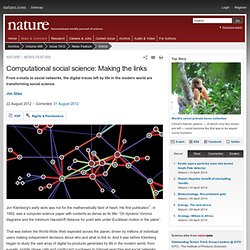
His first publication1, in 1992, was a computer-science paper with contents as dense as its title: 'On dynamic Voronoi diagrams and the minimum Hausdorff distance for point sets under Euclidean motion in the plane'. That was before the World-Wide Web exploded across the planet, driven by millions of individual users making independent decisions about who and what to link to. And it was before Kleinberg began to study the vast array of digital by-products generated by life in the modern world, from e-mails, mobile phone calls and credit-card purchases to Internet searches and social networks. Today, as a computer scientist at Cornell University in Ithaca, New York, Kleinberg uses these data to write papers such as 'How bad is forming your own opinion?
'2 and 'You had me at hello: how phrasing affects memorability'3 — titles that would be at home in a social-science journal. Kleinberg is not alone.
Social Network Analysis. Brief Description: "Social network analysis is the mapping and measuring of relationships and flows between people, groups, organisations, computers or other information/knowledge processing entities.
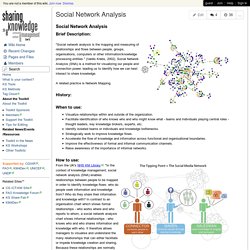
" (Valdis Krebs, 2002). Social Network Analysis (SNA) is a method for visualizing our people and connection power, leading us to identify how we can best interact to share knowledge. A related practice is Network Mapping.
Orgnet.com - Social Network Analysis software & services for organizations, communities, and their consultants. Applying algorithm to social networks can reveal hidden connections criminals use to commit fraud. Fraudsters beware: the more your social networks connect you and your accomplices to the crime, the easier it will be to shake you from the tree.
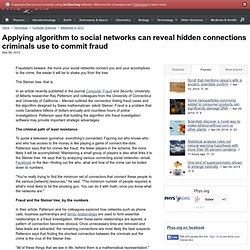
The Steiner tree, that is. In an article recently published in the journal Computer Fraud and Security, University of Alberta researcher Ray Patterson and colleagues from the University of Connecticut and University of California – Merced outlined the connection linking fraud cases and the algorithm designed by Swiss mathematician Jakob Steiner. Fraud is a problem that costs Canadians billions of dollars annually and countless hours of police investigations. Patterson says that building the algorithm into fraud investigation software may provide important strategic advantages.
The criminal path of least resistance To quote a television gumshoe, everything's connected. "You're really trying to find the minimum set of connectors that connect these people to the various [network] resources," he said.
Measuring Large-Scale Social Networks with High Resolution. This paper describes the deployment of a large-scale study designed to measure human interactions across a variety of communication channels, with high temporal resolution and spanning multiple years—the Copenhagen Networks Study.
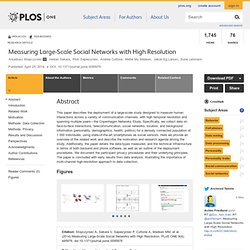
A search engine for social networks based on the behavior of ants. Research at Carlos III University in Madrid is developing an algorithm, based on ants' behavior when they are searching for food, which accelerates the search for relationships among elements that are present in social networks.
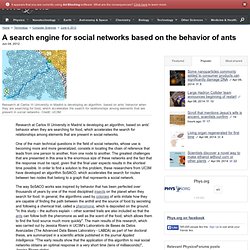
Open Tools, Open Data, Open Scholarship for Social Media. Mapping Twitter Topic Networks: From Polarized Crowds to Community Clusters. Polarized Crowds: Political conversations on Twitter Conversations on Twitter create networks with identifiable contours as people reply to and mention one another in their tweets.

These conversational structures differ, depending on the subject and the people driving the conversation. Six structures are regularly observed: divided, unified, fragmented, clustered, and inward and outward hub and spoke structures. These are created as individuals choose whom to reply to or mention in their Twitter messages and the structures tell a story about the nature of the conversation. If a topic is political, it is common to see two separate, polarized crowds take shape. While these polarized crowds are common in political conversations on Twitter, it is important to remember that the people who take the time to post and talk about political issues on Twitter are a special group. Conversational archetypes on Twitter Why is it useful to map the social landscape this way?
What this all means Figure 2. Is Twitter a Complex Adaptive System?
Facebook feelings are contagious: Study examines how emotions spread online. You can’t catch a cold from a friend online.
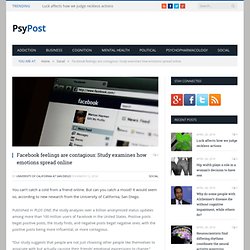
But can you catch a mood? It would seem so, according to new research from the University of California, San Diego. Published in PLOS ONE, the study analyzes over a billion anonymized status updates among more than 100 million users of Facebook in the United States. Positive posts beget positive posts, the study finds, and negative posts beget negative ones, with the positive posts being more influential, or more contagious. “Our study suggests that people are not just choosing other people like themselves to associate with but actually causing their friends’ emotional expressions to change,” said lead author James Fowler, professor of political science in the Division of Social Sciences and of medical genetics in the School of Medicine at UC San Diego.
There is abundant scientific literature on how emotion can spread among people – through direct contact, in person – not only among friends but also among strangers or near-strangers.
The Emerging Science of Superspreaders (And How to Tell If You're One Of Them)
Who are the most influential spreaders of information on a network?
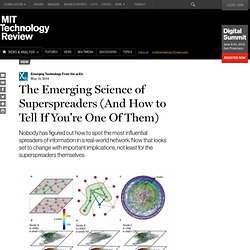
`bodycard 1205








